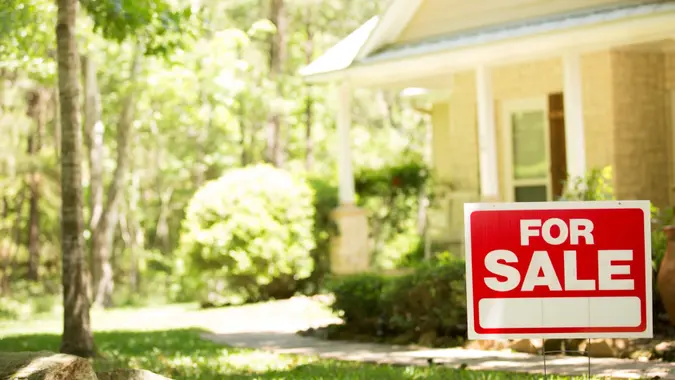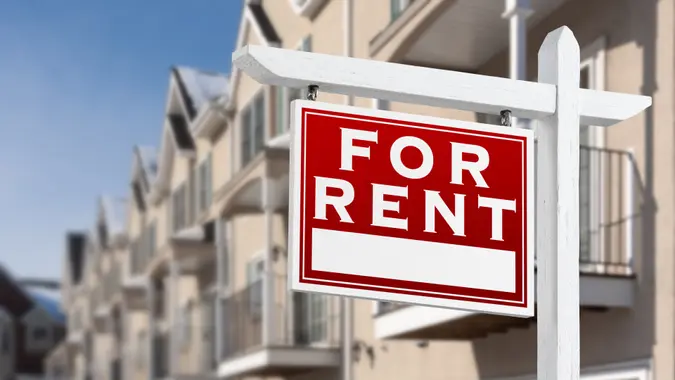What Are the Pros and Cons of Rent-To-Own Homes?

Commitment to Our Readers
GOBankingRates' editorial team is committed to bringing you unbiased reviews and information. We use data-driven methodologies to evaluate financial products and services - our reviews and ratings are not influenced by advertisers. You can read more about our editorial guidelines and our products and services review methodology.

20 Years
Helping You Live Richer

Reviewed
by Experts

Trusted by
Millions of Readers
Thinking about buying a home but not quite ready for a mortgage? Rent-to-own homes could be the perfect middle ground.
These unique agreements let you rent a property now with the option to buy it later — giving you time to save, improve your credit and ensure it’s the right fit. But like any real estate decision, rent-to-own has its ups and downs.
Let’s break down the pros and cons of rent-to-own homes so you can decide if it’s the right move for you.
What Is Rent-to-Own?
In a rent-to-own arrangement, you lease a home for a specific period with the option (or sometimes the obligation) to buy it at the end of the lease term. Each month, a portion of your rent may go toward the future purchase price, helping you build equity as you rent.
There are two main types of rent-to-own contracts:
- Lease Option: This gives you the right, but not the obligation, to purchase the home at the end of the lease.
- Lease Purchase: This legally obligates you to buy the home when the lease ends.
Both types help you ease into homeownership, but they come with different levels of commitment and risk.
Pros of Rent-to-Own Homes
Wondering why rent-to-own might be a smart choice? Here are the biggest benefits:
1. Build Equity as You Rent
A portion of your monthly rent payments goes towards your future down payment. Over time, these credits add up, helping you build equity before actually buying the home.
2. Lock in the Purchase Price
When you sign a rent-to-own agreement, the purchase price is often set at today’s market value. That’s a huge advantage if property values rise during your lease term.
3. More Time to Save and Improve Credit
Not quite ready for a traditional mortgage? Rent-to-own gives you time to save for a larger down payment and work on improving your credit score, increasing your chances of mortgage approval later.
4. Test Out the Home and Neighborhood
One of the unique perks of rent-to-own is the chance to “try before you buy.” You’ll live in the home and the neighborhood, giving you a real sense of whether it’s right for you long-term.
5. Avoid Moving Twice
If you’re already planning to buy, renting first means you can avoid the hassle of moving again once you’re ready to purchase.
Cons of Rent-to-Own Homes
Of course, rent-to-own isn’t perfect. Here are some potential downsides to keep in mind:
1. Higher Rent Payments
Monthly rent in a rent-to-own agreement is typically higher than standard market rent. That’s because part of your payment goes toward your eventual purchase.
2. Risk of Losing Money
If you decide not to buy the home — or can’t secure financing — you could lose any rent credits you’ve accumulated, along with your initial option fee.
3. Maintenance Responsibilities
In many rent-to-own agreements, the tenant is responsible for maintenance and repairs. This means you could end up paying to fix a home you don’t yet own.
4. Limited Inventory
Rent-to-own homes aren’t as common as traditional rentals, so finding a suitable property can take time. Plus, these options may be more prevalent in certain areas than others.
5. Pressure to Buy
With money already invested through option fees and rent credits, you might feel pressured to buy the home — even if your circumstances change or the market shifts.
Quick Comparison: Pros and Cons Table
| Pros | Cons |
|---|---|
| Builds equity while renting | Higher rent payments |
| Locks in purchase price | Risk of losing option fees and credits |
| Time to save and improve credit | Maintenance responsibilities |
| Test the home and neighborhood | Limited home options |
| Avoids moving twice | Pressure to buy even if circumstances change |
How Does Rent-to-Own Work?
If you’re curious about how rent-to-own actually works, here’s a step-by-step breakdown:
- Find the Property: Look for a home where the seller is open to a rent-to-own agreement.
- Negotiate the Terms: This includes the rental period, the purchase price, monthly rent, and how much of the rent will go toward the purchase.
- Pay the Option Fee: This upfront, non-refundable fee gives you the right to buy later. It’s usually around 1 to 5% of the home’s purchase price.
- Start Renting: During the lease, you pay monthly rent, which may include a premium portion credited toward the purchase.
- Decide Whether to Buy: At the end of the lease term, you can purchase the home using your accumulated credits or walk away (if you’re in a lease option agreement).
Is Rent-to-Own Right for You?
A rent-to-own home could be a good fit if:
- You’re working on improving your credit score.
- You need more time to save for a down payment.
- You’re unsure about committing to a specific home or neighborhood.
- You want to lock in today’s prices but aren’t ready to buy immediately.
However, if you’re uncertain about future finances or career plans or you anticipate needing flexibility in your living situation, renting-to-own may not be the best option.
What to Look for in a Rent-to-Own Agreement
Before signing on the dotted line, make sure the following terms are clearly defined in your rent-to-own agreement:
- Purchase Price: Is it locked in or based on future market value?
- Option Fee: How much is it, and will it go toward the purchase price?
- Rent Credits: How much of your rent counts toward the down payment?
- Maintenance Responsibilities: Who handles repairs and upkeep?
- End-of-Lease Terms: What happens if you choose not to buy?
Make sure to have an attorney review the contract to ensure you’re protected.
Rent-to-Own vs. Buying a Home Directly
Not sure if rent-to-own is better than buying outright? Here’s a quick comparison:
| Factor | Rent-to-Own | Buying a Home Directly |
|---|---|---|
| Upfront Costs | Option fee, higher rent | Down payment, closing costs |
| Flexibility | More flexible, but risk of losing credits | Less flexible, but no risk of losing credits |
| Commitment | Lower initial commitment | Full commitment at purchase |
| Time to Save | Yes | No |
| Market Risk | Locked-in price could be a win or loss | Directly affected by market changes |
Final Take to GO
Rent-to-own homes offer a unique and flexible path to homeownership, especially if you’re not ready to commit to a mortgage. The key is understanding the pros and cons of rent-to-own homes — from the chance to build equity and lock in a purchase price to the risk of losing option fees if plans change.
Before signing an agreement, weigh the benefits and potential pitfalls. And if you’re ready to dive in, consider having a legal expert review the contract to protect your investment.
Still weighing your options? Take your time, do your research and choose the homeownership path that aligns best with your long-term financial goals.
FAQs About Rent-to-Own Homes
In today's turbulent housing market, it's more than reasonable to explore all of your options. Here are some common questions and concerns that might come up while looking into the pros and cons of rent-to-own homes:- Can I back out of a rent-to-own contract?
- Yes, if you have a lease option agreement. But you'll likely lose your option fee and rent credits.
- Are rent-to-own homes more expensive?
- Yes, monthly payments tend to be higher to account for rent credits. However, you’re investing in future ownership.
- What if I can’t buy the house after renting?
- You may face legal consequences if you're in a lease purchase agreement. A lease option agreement allows more flexibility.
- How does rent-to-own affect my credit score?
- Making rent payments on time may help improve your credit, especially if the landlord reports to credit bureaus.
Information is accurate as of March 14, 2025.
Editorial Note: This content is not provided by any entity covered in this article. Any opinions, analyses, reviews, ratings or recommendations expressed in this article are those of the author alone and have not been reviewed, approved or otherwise endorsed by any entity named in this article.
Our in-house research team and on-site financial experts work together to create content that’s accurate, impartial, and up to date. We fact-check every single statistic, quote and fact using trusted primary resources to make sure the information we provide is correct. You can learn more about GOBankingRates’ processes and standards in our editorial policy.
- Zillow "How Does Rent-To-Own Work?"
- National Association of Realtors "Lease-Option Purchases"
- Consumer Financial Protection Bureau "How do I get and keep a good credit score?"
- Realtor.com "The Most Common Rent-to-Own Scams—and How to Not Get Taken for a Fool"
- Federal Trade Commission "Buy Now, Pay Later, Rent-to-Own, Lease-to-Own, and Layaway"
 Written by
Written by  Edited by
Edited by 

























